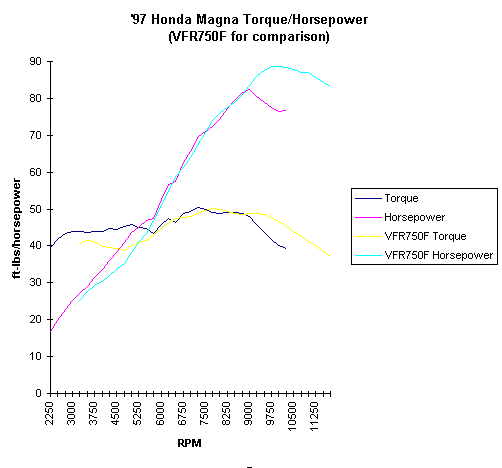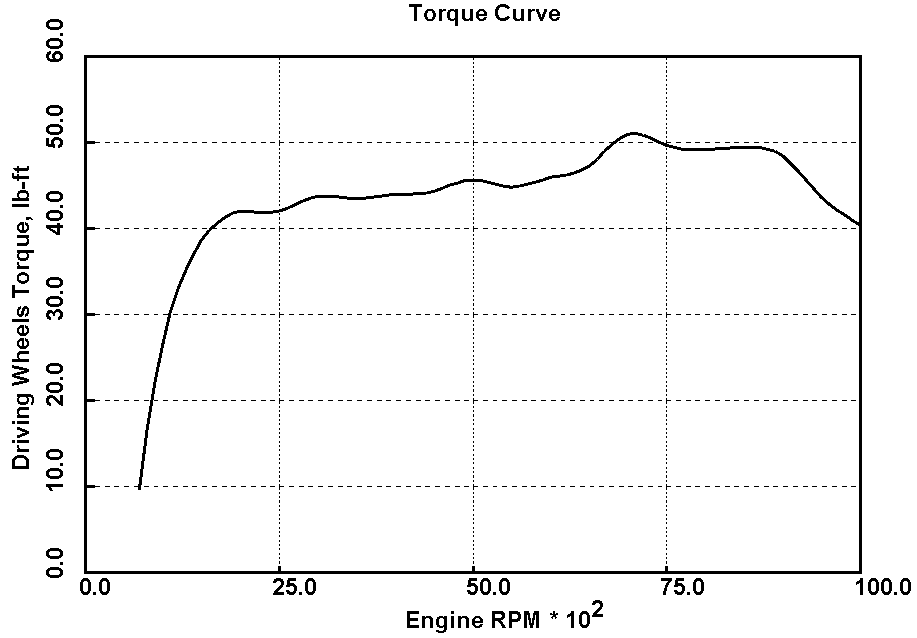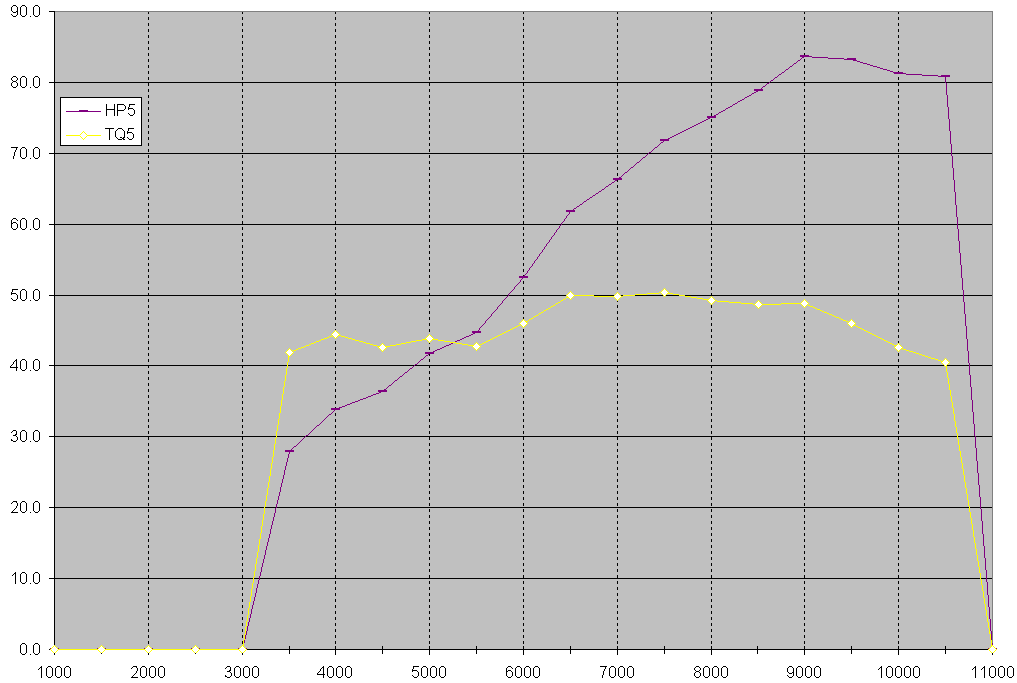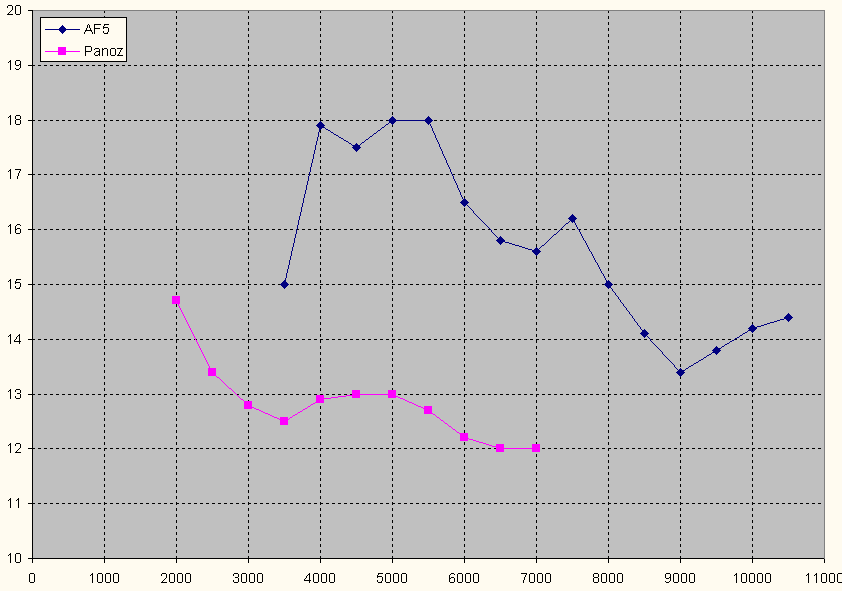Mike's Magna FAQ
This FAQ pertains to the Honda Magna motorcycle from '94 to present.
Click
here
for a review of the Vance & Hines exhaust system.
Click
here
for a review of the Dyna 3k Ignition.
What models were made?
During this time period there were three models made; the differences are mostly cosmetic.
The base model was and remains the VF750C.
There is also a VF750C2.
Early on, this model had a two-tone paint job and a small targa style fairing.
Later, Honda dropped the fairing but retained the paint.
All models are the same in every other respect: size, weight, engine, etc.
What are the specifications?
You can get the basic specs just about anywhere, for example
here.
But Honda does not publish power / torque numbers.
Bone stock, these bikes put out about 75-80 RWHP and 42-48 RWTQ on a dyno.
Torque peaks at 7k RPM, power peaks at 9k.
Here is one dyno chart of a bone stock Magna:

Below are dyno charts from a Magna with:
Dave Dodge jet/shim kit
K&N air filter
aftermarket exhaust


Below are dyno charts from a Magna with:
aftermarket exhaust (everything else bone stock)
You can see that the engine is too lean throughout the entire RPM range,
but the lean condition is especially bad in the bottom half of the RPM range.
This is causing the engine to have anemic low end torque.


Does the Magna require high octane fuel?
Contrary to popular belief, the Magna does not need high octane fuel.
It runs best on 87 octane fuel and there is no benefit to running anything higher.
Some of the overly lean CA model bikes ping lightly on 87 and run better with 89 octane.
However, after installing a jet/shim kit to richen the mixture, 87 can again be used.
Of course, if compression or timing advance is increased, then high octane fuel may be needed.
What kind oil does the Magna require?
The Magna has a modern water cooled engine as seen by the fact that Honda recommends 10w40 oil changed at 8k / 1 year intervals
(whichever comes first).
The only special note regarding oil is that Honda dis-recommends the use of energy conserving oils
(as they may adversely affect the wet clutch).
Many believe an 8k change interval is too long, especially with a Group II (regular old dino-juice) oil.
However, this belief is based more on tradition and myth than on engineering or tribology.
Most "motorcycle specific" oils are regular old dino juice repackaged and priced 4-5 times higher.
Many Magna riders use Mobil 1 super-syn in the 15w50 weight (known as "the red cap").
This is a true Group IV synthetic oil with no friction modifiers or reducers.
Mobil 1 also makes a "motorcycle specific" synthetic that costs twice as much ($8 vs. $4 per quart),
but some tests have shown that this is the same oil as "the red cap",
only repackaged and priced twice as high.
How are they geared?
In top gear going down the freeway, a bone stock Magna pulls 5k RPM @ 75 MPH.
This is exactly 1/2 of its 10k RPM redline.
Its 90 degree quad cam V-4 engine makes it essentially vibration free from idle to redline.
It will happily spin at these revs and higher all day long with no fatiguing vibration.
How reliable are they?
Typical Honda bulletproof reliability.
Some owners have reported 100k trouble free miles with regular maintenance
(oil changes, air filters, tires, etc.).
What is the maintenance like?
Like any modern Japanese motorbike, maintenance is minimal.
Honda recommends lubing & adjusting the drive chain every 600-1000 miles,
and chaning the air filter, oil filter & oil every 8k miles.
What drawbacks or limitations does it have?
The Magna is a superb bike, but Honda did cut some corners to keep costs down.
The items most owners complain about are:
rear drum brake: speaks for itself
single front disc brake: dual discs would be nicer
overly lean carbueration: easily fixed with an inexpensive jet/shim kit
limited cruising range: typically 100-120 miles to reserve
What modifications are recommended?
Carbs, stage 1
The first mod most people do is to adjust the carbs to correct the stock lean condition.
In stock trim, the low end torque is a bit anemic and there is a mild flat spot between 5k and 6k RPM
(visible in the above dyno chart).
The low end lean condition can be fixed simply by adjusting the pilot mixture screws.
In stock trim they are around 2 turns open.
Setting them all to 2 5/8 turns will eliminate part throttle lean surging and smooth out the throttle response.
Doing this will require a special "D" shaped screw on an "L" bend wrench.
Carbs, stage 2
Stage 1 improves throttle response but does not fix the flat spot.
The flat spot can be fixed only by shimming the main jet needles to allow more fuel to flow from the main jet when the needle is at rest.
This richens the mixture at the transition point from the low speed to high speed circuit.
Stage 2 is to install a jet/shim kit which does exactly this and improves power / torque output.
The best kit costs around $50 from Dave Dodge at
Dodge Racing Products.
It uses dyno proven settings and is completely reversible as it does not require drilling.
Exhaust
Another popular mod is to use an aftermarket exhaust system.
This not only improves the sound and look of the bike, but it can also improve torque & power.
However, all aftermarket exhausts will require a jet/shim kit,
else they will make the bike run worse than stock.
This is why it's a good idea to do the jet/shim kit first.
The two best exhaust systems are the Vance & Hines and the Supertrapp.
They are best in terms of power / torque output and also in build quality and finish.
Air Filter
K&N makes an air filter for the Magna.
It provides for a slight yet insignificant power increase.
However, it is higher quality than the stock air filter,
seals the air box better, is reusable, and costs about the same as stock.
This makes it a decent and popular upgrade from stock.
Gearing
The Magna's stock gearing uses a 16T front and 40T rear,
for an overall 2.5:1 ratio that is a compromise between racing and cruising.
It's easier to swap the front than to swap the rear.
For freeway cruising, a 17T front sprocket is 6% taller than stock, providing 4700 RPM @ 75 MPH.
For drag racing, a 15T front sprocket is 6% shorter than stock, providing 5300 RPM @ 75 MPH.
Dyna Ignition
As you can see in the above dyno chart, power starts falling @ 9k RPM.
This is in part because the stock ignition pulls 5 degrees of timing at 9k RPM
(presumably, to soften the potential bump into the stock rev limiter @ 10.5k RPM).
The
Dyna ignition
provides 3 main benefits:
First, it maintains full timing all the way to the rev limiter, improving top end power.
Second, it lets you change the RPM at which the rev limiter kicks in.
Third, it provides a more aggressing timing advance at low RPM, to improve low end torque.
Getting the most out of the Dyna ignition requires the Stage 2 carb and exhaust mods.
This is because the overly lean stock A/F ratio will ping if the timing is advanced.
Brakes
A powerful bike like the Magna needs good brakes.
An easy and popular way to improve the brakes is to replace the front hose with a stainless steel braided hose.
The best quality ones have a plastic clear coat over the stainless steel to prevent rust.
Check out the
mods
page for tips on how to install the hose & bleed the system afterwards.
Wind Protection
The Magna is a naked cruiser with no wind protection.
For those who hate windshields but want a little bit of wind protection,
I personally recommend and use a NYC flyscreen.
It smooths out the airflow and keeps the freeway wind out of your gut,
directing the wind force to your chest area but still below the helmet.
This provides more comfortable and stable freeway riding.
Suspension
Another common mod is to replace the front fork springs with Progressives.
This provides better braking and cornering for improved overall handling.
Seat
Many find the stock seat to be uncomfortable.
The two most popular replacement seats are Corbin and Mustang.
Corbin is considered best for 1-up riding,
Mustang for 2-up riding.




